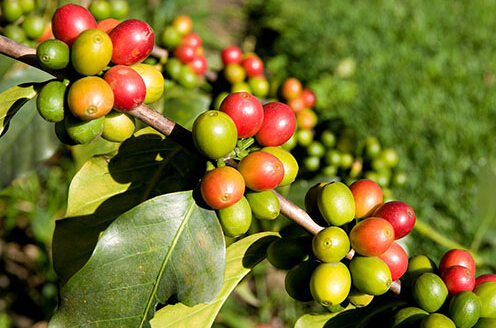The relationship between the Flavor of Coffee and its growth altitude
We should all understand that raw coffee beans are generally graded according to their size, defect rate and altitude. The size and defect rate of raw beans are easy to understand, and many people do not quite understand why some producing areas use the altitude of coffee beans as the basis for grading, and many coffee sellers also sell their coffee at a high price because they boast that their coffee is high-altitude coffee. This is also the most common problem encountered in grading to students.

Today, the school cafe will systematically sort out why coffee beans are graded according to the elevation:
First of all, we should realize that the influence of geographical location on the flavor of coffee beans is profound. All coffee grows in the tropics, in fact, altitude has no direct effect on coffee, but altitude can affect the growth, development and quality of coffee through the redistribution of meteorological elements (temperature, light, heat, wind speed, rainfall, etc.). The tropics between the Tropic of Cancer and the Tropic of Cancer produce the world's truly high-quality Arabica coffee.
Central and South America, South Asia and some Pacific islands, and south-central Africa are also the most important coffee-growing areas in the world. The 3000-6000 ft (90-2000 m) high altitude provides ideal conditions for coffee to grow: an average frost-free climate of 60-70 degrees Fahrenheit (15-21 ℃) throughout the year, about 80 inches of moderate rainfall, and abundant sunshine.
Coffee beans in cold mountain areas grow more slowly, and the slow ripening process makes coffee beans have higher sugar content, more interesting flavor and more mellow flavor. High elevations have a high displacement and produce more concentrated fruit flavors, and the best Arabica coffee-growing areas have very fertile soil, often in volcanic areas.

Coffee beans grown at high elevations are hard, dense and have the potential to give full play to their special flavor. The really amazing coffee bean growing areas are at high elevations, and these coffee beans are only picked carefully during the mature season. Generally speaking, with the increase of altitude, the aroma of coffee will become more and more prominent and unique. From the temperature and sweetness of Brazilian beans at 3500 feet to the soaring taste of Ethiopian coffee beans above 6000 feet, altitude will give coffee beans a more complex and subtle taste.
Central American coffee is rated according to the altitude at which coffee is grown, Mexico, Honduras, Haiti and other countries according to the height of Strictly High Grown (extremely high mountain beans, referred to as SHG), followed by High Grown (high mountain beans, referred to as HG) Mexico called Altura, which means "high" in Spanish, indicating that this is high-altitude coffee. Papua New Guinea adds the name "Mile High" to mark coffee beans grown in the highlands and mountains.
On the other hand, due to the cold climate and slow growth of coffee in alpine areas, the density of raw beans is higher and the texture is harder, and the more mellow and aromatic the coffee is, and it has a supple sour taste; on the other hand, in lower areas, the density of raw beans is smaller and the texture is less hard, the worse the quality of coffee is, so some people classify it as "hardness".

Practice shows that the effect of altitude on quality has exceeded that of genotype on quality. However, I think that the classification of coffee beans based on altitude is more scientific and reasonable than simply grading by size and defect rate, because to a certain extent, altitude classification is indirectly graded by taste, and beans with low altitude grow rapidly and large. the defect rate can be changed by selection, but the altitude cannot be changed.
According to the measurement, compared with the same kind of coffee beans, the higher the altitude, the greater the acidity and the smaller the concentration; on the contrary, the smaller the acidity, the greater the concentration. Therefore, for friends who like sour taste and do not require high concentration, high-altitude coffee is very suitable for you, it is your good coffee; for friends who do not like sour taste and require high concentration of coffee, the higher the altitude, the more unsuitable for them. No matter how high its quality is, it is also a waste product for itself. Therefore, the choice of altitude should be based on personal taste.
How do we know if the coffee we buy is really high altitude? Coffee growth and reproduction has specific requirements for environmental conditions, sexual preference for calm wind, cool, shaded or semi-shaded environment. In other words, coffee can not be grown and produced in any environment, that is to say, coffee production is divided into different regions. Coffee producing areas in the world are mostly distributed in tropical plateaus or high-altitude mountain areas. The equatorial area has high calories and can be planted to about 2000 meters above sea level. The calories on both sides of the Tropic of Cancer are relatively low, most of which are below 1000 meters. In China, it is mainly distributed in Yunnan.
Important Notice :
前街咖啡 FrontStreet Coffee has moved to new addredd:
FrontStreet Coffee Address: 315,Donghua East Road,GuangZhou
Tel:020 38364473
- Prev

On the weekend, let's dissect the coffee fruit together.
We often drink coffee, but few people have seen coffee beans, let alone coffee fruits. Lao WA talked about delicious coffee every day, but never talked about the past lives of coffee beans. On the weekend, let's deeply dissect the past life of coffee beans to see what it is like to make a cup of delicious coffee fruit. Most of the coffee producing areas in the world are located in the south.
- Next

Coffee basic knowledge you do not know the 20 small uses of coffee?
Remove Kill fridge odor from the refrigerator leftovers, almost rotten food, and spoiled milk, all of which smell bad. If your refrigerator smells bad, you can keep a bowl of fresh, unused coffee powder in the fridge for 1 to 2 days. Coffee powder will absorb those bad smells, and you want to make a cup of coffee when you open the refrigerator door.
Related
- Detailed explanation of Jadeite planting Land in Panamanian Jadeite Manor introduction to the grading system of Jadeite competitive bidding, Red bid, Green bid and Rose Summer
- Story of Coffee planting in Brenka region of Costa Rica Stonehenge Manor anaerobic heavy honey treatment of flavor mouth
- What's on the barrel of Blue Mountain Coffee beans?
- Can American coffee also pull flowers? How to use hot American style to pull out a good-looking pattern?
- Can you make a cold extract with coffee beans? What is the right proportion for cold-extracted coffee formula?
- Indonesian PWN Gold Mandrine Coffee Origin Features Flavor How to Chong? Mandolin coffee is American.
- A brief introduction to the flavor characteristics of Brazilian yellow bourbon coffee beans
- What is the effect of different water quality on the flavor of cold-extracted coffee? What kind of water is best for brewing coffee?
- Why do you think of Rose Summer whenever you mention Panamanian coffee?
- Introduction to the characteristics of authentic blue mountain coffee bean producing areas? What is the CIB Coffee Authority in Jamaica?

